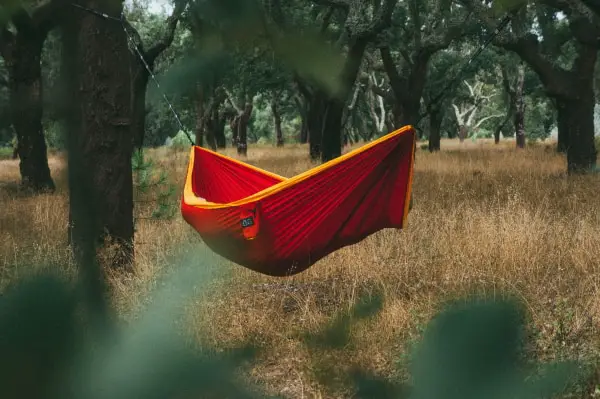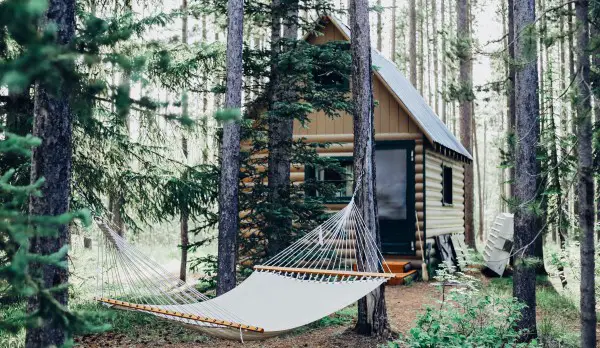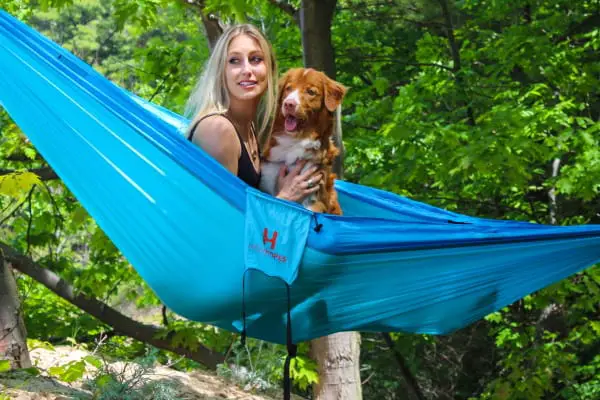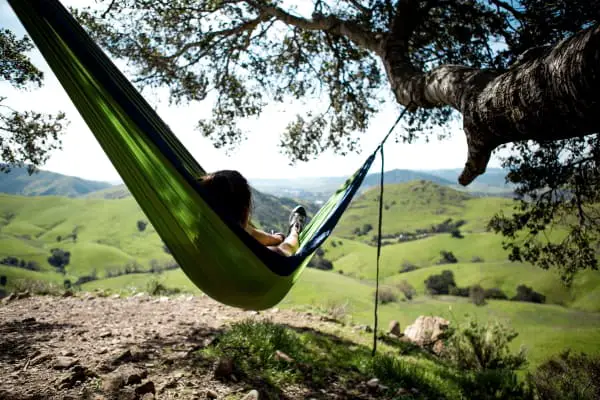
Hammock camping has been gaining traction over the years and many people are now using them on the Appalachian Trail. Are you interested in buying a hammock for camping?
Wondering what the advantages of hammock camping might be? Trying to decide if hammock camping is better than tent camping?
In this post, I’ll answer all of these questions and more.
Table of Contents
What is Hammock Camping
Before we get into this post, I’d like to point out that hammock camping uses hammocks that are much different than your average backyard hammock. This doesn’t mean you can’t bring a backyard hammock with you on your camping trip, but it won’t be the same type of hammock you’d bring on a backpacking trip.
Also, a backyard hammock isn’t going to be comfortable to sleep in even if you’re car camping. If you do decide to sleep overnight in a hammock, even on a car camping trip, I’d recommend you go with a hammock that is specifically designed for camping.
Still not sure what I mean by a backyard hammock? Take a look at the image below. You’ll notice that it looks much different than the image at the top of this post.

Now that you know what hammock camping is and what it isn’t, let’s talk about some of the reasons why you might want to go hammock camping instead of tent camping, tarp camping, or bivy camping.
Hammock Camping Advantages
Here are some of the advantages of camping with a hammock.
- Hammocks often weigh less than tents.
- Hammocks take up a lot less space in a backpack.
- Many people find hammocks to be more comfortable to sleep in.
- A hammock can be set up in areas where tents cannot.
- Hammocks often last longer than tents and bivy sacks.
- Hammocks get you off the ground.
- You don’t have to crawl into a hammock.
- Hammocks are highly visible.
- A hammock can be repurposed during emergencies.
Weight
A backpacking hammock can weigh less than 1 pound and even heavier hammocks only weigh two to three pounds. This makes the camping hammock a great option for any backpacker who is looking to shed some weight from their backpack.
Space
Hammocks also take up much less space than a traditional tent would inside of your backpack. This is mostly because hammocks don’t have tent poles but also because they usually have less material as well. Additionally, the parts of a hammock can be divided up easier than the parts of a tent so you can be more strategic about how you pack your hammock up versus how you pack your tent into your backpack.
Comfort
Many people feel that sleeping in a hammock is a lot more comfortable than sleeping in a tent. This is probably because the hammock floats you over the ground so you don’t have to contend with hard, rough, or uneven surfaces.
Campsite Location
One of the greatest benefits of hammock camping is that it makes choosing a campsite much easier. You don’t have to worry about finding a level area free from rocks and sticks like you would with a tent or bivy camping setup.
You also don’t have to worry about mud or even small puddles as you’ll be floating over them anyway. I’ve even seen people set their hammocks up in marshland but I wouldn’t recommend it. I could see the marsh filling up and it being difficult or even impossible to hike out of the area in the morning.
Durability
The bottom of a hammock isn’t exposed to the ground so it’s much less likely to suffer from punctures the same way a tent would. Also, because it’s off the ground, a punctured bottom isn’t going to leave you wet like the punctured bottom of a tent might.
Additionally, the top of the hammock is usually covered with a tarp so your hammock is less likely to get hit by stray branches. Combine these two factors and it’s easy to see why some camping manufacturers will offer lifetime warranties on their hammocks.
Elevation
A hammock gets you off the ground so you don’t have to worry quite as much about bugs. This means you won’t have to worry as much about sleeping on top of a fire ant or roach nest.

It also means that you don’t have to worry about packing a camp chair because you can just sit on top of your hammock instead. This will cut your backpack’s weight down even further and will make you more comfortable on your trip.
Entry and Exit
Hammocks are easier to get in and out of than most camping setups. Instead of crawling into them and rolling out of them, you just need to sit up and put your legs onto the ground.
Getting out of a hammock is a much better start to the morning than getting out of a tent and it just feels a bit more civilized. On the other hand, a devoted yogi might find this unsatisfying as they won’t be able to enjoy the feeling of being grounded.
Visibility
A hammock is usually a lot more visible than a tent. This means it can often be safer to camp in a hammock during hunting season than it is to camp in a tent.
It also means that you’ll be less likely to trip over your shelter at night and you’ll be more likely to find it should you wander away from camp when answering nature’s call at night.
Emergency Use
A hammock can be great to have on hand during an emergency.
Hammocks can be hung up for emergency personnel to have an easier time finding you. The straps of the hammock can be used to apply tourniquets and the hammock itself could be used to make splints, stretchers and all sorts of other emergency devices.
Hammock Camping Disadvantages
- It has a much higher learning curve than other shelter options.
- It can cost more than other options.
- You can’t hammock camp without trees.
- Hammocks aren’t always allowed in state and national parks.
- Hammocks aren’t pet-friendly.
- You’re more exposed to the wind when hammock camping.
- You’ll have less privacy in a hammock.
- You could be more susceptible to local wildlife and people.
- A hammock can only sleep one or two people.
- You don’t have much interior space.
The Learning Curve
Setting up a hammock isn’t necessarily any more difficult than setting up a tent but it does take work. On top of this, setting up a hammock isn’t quite as intuitive as setting up a tent or bivy so you will have some learning to do before you can get started.
Cost
Some people list the cost of hammock camping as a pro and some as a con. I’ve listed it as a con since there are often additional costs to hammock camping that have to be added to the total cost.
For example, a hammock camper needs to buy bug netting, a tarp, and usually an underquilt as well. On top of this, they may need to buy additional straps to hang the hammock. Tent and bivy owners just need to buy a sleeping pad to add to the inside of their shelter and this usually doesn’t cost much.
Limited Set-Up Options
The biggest downfall of the camping hammock is that it won’t work without trees. This means that desert campers, mountaineers, and people backpacking through sparse or newly grown forests might not have anywhere to set up their hammocks.
Legal Issues
More and more people are using hammocks on their backpacking and camping trips. Unfortunately, many of these people aren’t bothering to learn how to properly set these hammocks up so that they don’t damage or kill the trees they hang from.
Because of this, many state and national parks have banned the use of camping hammocks within their boundaries. Before venturing out, you’ll want to make sure that there aren’t bans in place at your intended camping area.
Pet Problems
Do you like to go camping with your cat or dog? If so, you might be better off in a tent.

Pets will have a much easier time getting in and out of a tent than they will a hammock. Also, it’s usually easier to protect the bottom of a tent from punctures than it is to protect the hammock from punctures and your pet’s claws could become an issue for your hammock.
Wind Exposure
Hammocks are up higher and exposed to more wind than a tent, bivy, or tarp setup. In fact, in some areas, you may find that setting up a hammock just isn’t feasible.
Privacy Issues
Even small tents provide you with your own miniature room to get dressed in and to do tick checks in. A hammock isn’t going to provide you with this protection.
Wildlife and People
Because of the lack of privacy, you’re more exposed to both people and wildlife. A bear, a mountain lion, or even a person might see you fast asleep in your hammock and they may be more tempted to mess with you than they would be if you were blocked off from sight in your tent.
Less Group Camping Options
There are double hammock tents that you can buy, but I can’t imagine they’re very comfortable to sleep in. Each time you or your bunkmate move, you’ll be moving the entire hammock which could lead to you disturbing each other all night.
Less Interior Space
A hammock doesn’t offer interior space to hang out in. You aren’t going to be inviting your friends to play cards in your hammock when it’s raining and you aren’t going to be completely shielded from the elements in your hammock unless you’re lying in it.
On top of this, you aren’t going to have space to store much of your gear inside of the hammock either. Yes, some hammocks have gear bags that you can connect to them, but these aren’t going to support your entire backpack so you’ll have to leave that underneath of your hammock and hope that it doesn’t get wet or filled with bugs.
How to Choose a Camping Hammock
So you’ve decided to get into the wonderful world of hammock camping and to buy your first camping hammock. What do you need to look for?
Before buying a camping hammock, you’ll need to decide on a type of hammock to buy. Then you’ll have to choose a hammock size.
Lastly, you’ll need to find out what types of accessories you’ll need so you can buy them as well. These accessories might include the suspension system, bug netting, a tarp, and something to help keep you warm at night.
Types of Hammocks
There is a multitude of camping hammocks to choose from and you’ll need to learn a little about each before you make your first buy.
The main types of camping hammocks are:
- Asymmetrical hammocks.
- Symmetrical hammocks.
- Gathered hammocks.
- Bridge hammocks.
- Single Layer Hammocks.
- Double Layer Hammocks.
- Two-person Hammocks.
Asymmetrical and Symmetrical Hammocks
An asymmetrical hammock gets its name from its shape in that it is built asymmetrically. What I mean by this is that the ends are not shaped the same on each side. Picture a parallelogram rather than a rectangle.
Of course, this isn’t always true. Sometimes asymmetrical just means you get a rectangular-shaped hammock that has its netting integrated so that the netting is asymmetrical. This allows you to lay your head at one end and your feet on the opposing end so that you can still lay diagonally.
This allows you to lay diagonally inside of the hammock. The benefit of this is that when you lay diagonally, you flatten out the hammock and end up sleeping on a nearly flat surface rather than in a banana shape like you would if you weren’t laying diagonally across the hammock.
The asymmetrical hammock is the most popular type of hammock among campers and backpackers. This is probably because it’s a more natural sleeping position and most people get a better night’s sleep out of it.
The symmetrical hammock is just a rectangular shaped hammock. You can sleep in it diagonally just as you would a true asymmetrical hammock. You’ll just need to set the netting up so that it doesn’t stop you from doing so.
Gathered-end Hammocks and Bridge Hammocks
The words gathered-end and bridge refer to the way the end of the hammock is designed. Gathered-end hammocks bunch the ends of the hammock into one point.
This type of hammock design makes the hammock very light as there aren’t any poles at the end. It also makes the hammock pack down small so it’s ideal for backpackers who like to hammock camp.

Bridge hammocks do not gather the ends into bunches. Instead, the end goes to a spreader bar which then attaches to your suspension system.
The advantage of the bridge hammock is that it creates a tubular shape that is flat without the need to lay diagonally. The obvious drawback is that you have a spreader bar system to deal with and this will take up space and add weight to your pack.
Some manufacturers have tried to get around this disadvantage by creating a bridge hammock that can be set up with your trekking poles fulfilling the role of the spreader bar. This is a nice alternative but it can make setting up the hammock a bit more difficult.
Single and Double Layer Hammocks
A hammock can also be built as a single or a double layer hammock. With a single-layer hammock, you just get one sheet of material. This keeps the system simple and it keeps the weight down to the bare minimum.
A double-layer hammock has two layers of fabric. This gives you a few advantages over the single-layer hammock.
For starters, you have more support and a bit of redundancy since you do have two layers underneath of you. On top of this, the layers are usually designed so that you can slide a sleeping pad in between them. This can be a little bit more comfortable than placing the sleeping pad directly underneath of you as the pad tends to move around less inside of a double-layer hammock than within a single-layer hammock.
Double Hammocks
A double hammock is a hammock that is designed for two people. These hammocks are basically just wide hammocks that are designed so that two people could theoretically sleep in them.
I’ve laid in backyard hammocks with other people but never a camping hammock with another person. However, I’ve heard from people who have and I’ve yet to hear from anyone that recommended doing it.
Hammock Sizes
A hammocks size is very important. In order for you to get a comfortable night’s sleep, you’ll need a hammock that is both wide enough and long enough for your particular body.
Sleep in a hammock that is too narrow for you and you won’t be able to lay diagonally very well. You’ll end up developing what is known as calf ridge and it’ll keep you up at night.
Don’t worry, calf ridge isn’t a serious condition and it’s not permanent. It’s a condition that is caused when the bunched up end of your hammock cuts into your calf as you attempt to lay diagonally. The shorter the hammock, the quicker you’ll notice this phenomenon.
The hammock will also need to be long enough for you as well. Most experts agree that your hammock should be about 4 feet longer than you are.
Hammock Materials
Once you’ve chosen a type of hammock and determined the best size for you, you’ll then need to decide on a hammock fabric. The hammock fabric you choose will need to be sturdy enough to support your body weight. Luckily, you don’t have to guess with this as the manufacturer will typically give their hammock a weight rating.
You’ll also want to decide whether or not the bottom of the hammock needs to be waterproof. If you do get a hammock with waterproof material on the bottom, you may be able to use it as a ground bivy. However, a waterproof hammock may not be as breathable as one that isn’t waterproof and it’ll probably cost more, so you’ll want to weigh your options carefully.
The most popular material used to make camping hammocks is nylon but polyester can be used as well. These two materials are often then combined with other materials to make different blends to suit the user’s needs. An example of this would be silnylon, which is a mixture of silicone and nylon. You’ll also find this to be true with tarps as well.
Keeping Warm While Hammock Camping
Hammock camping gets you off the ground so you don’t have to worry about losing your body heat to conduction like you would when sleeping on the ground. The problem is that you do have to worry about losing your body heat due to convection. This happens when air moves underneath of you and it can be reduced with the use of insulation.
One way to insulate your hammock is to use a sleeping pad underneath you. This will create a barrier between you and the air underneath of you so you won’t lose all of your body’s heat to the open air.
The downside to this is that it isn’t always comfortable and it doesn’t insulate you as well as a hammock quilt does. This brings us to the other way of keeping warm while hammock camping, which is to use a quilt with your hammock.
A hammock quilt is essentially a quilt that wraps around the outside of your hammock. It creates an air gap between you and the outside and can be incredibly effective at keeping you warm.
These quilts come in different thicknesses for different temperatures and they’ll come with temperature ratings just like a sleeping bag. Between your quilt and your sleeping bag, you can stay incredibly warm in a backpacking hammock even in temperatures below freezing.
Hammock Camping Add-ons
In addition to your camping quilt, you may also need to add bug netting as well as a tarp system to your hammock. Some hammocks will come with these two items and some won’t.
Tarps come in a lot of different materials and they can be suspended over you in a few different ways. The main thing you need to know is that tarps should be used even if it isn’t raining.
This is because tarps will keep the wind from hitting you and the leaves and small tree branches from falling on you. It will also block out the sun so you don’t always have to wake up at first light.
How to Setup and Use a Camping Hammock
To set your hammock up, you’ll need to find a safe area devoid of dead trees that may fall on you and away from areas that might drop rocks onto you. You’ll also want to stay away from areas that could flood as well.
Alternatively, you could set up really high into the treetops but I wouldn’t recommend it. In fact, I’m a big believer in not setting my hammock up higher than I would want to fall and I think most people would agree with me.
Once you’ve found a suitable spot, you’ll need to find two sturdy trees that are spaced appropriately apart. This will vary depending on the length of your hammock but obviously you’ll need to account for your hammock’s length as well as the length of your suspension system.
After you’ve found your trees, it’s just a matter of actually suspending your hammock, attaching your bug netting, and suspending your tarp. This will vary depending on your hammock and the system you’re using, but the video below from Outdoor Adventures does a pretty good job of showing you what you might expect.
Summing It All Up
Hammock camping is great for backpackers and for campers who are looking to try something different. It does come with a learning curve however so you’ll need to practice a bit before you head out on the trail.
My advice would be to go on a car camping trip with your backpacking hammock and your tent. This way you’ll be able to practice setting up and sleeping in your hammock knowing that you can always use your tent if things don’t work out.
Once you’ve gained some confidence with your hammock, you can then head out on a backpacking trip with it.



